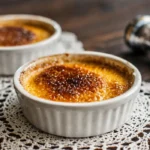
Crème Brûlée, a quintessence of French dessert, is revered for its rich, creamy custard base and a contrasting top layer of hard caramel. This guide dives into the intricacies of How to make a creme brulee top ensuring that you can replicate the perfection of this dessert in your kitchen.
Introduction to Crème Brûlée
At its core, crème brûlée is a symphony of simplicity and complexity. Its origins, deeply rooted in the realms of French cuisine, reflect a long history of culinary excellence. The dessert’s allure lies not just in its taste but in the textural contrast between the silky custard and the brittle caramelized sugar topping.
Essential Ingredients and Tools
Creating the perfect crème brûlée requires precision, both in technique and in the choice of ingredients:
- Heavy cream for a lush texture
- Egg yolks for richness and color
- Sugar, both for the custard and the crystalline top
- Vanilla, for an aromatic depth

The equipment is just as crucial, with ramekins and a culinary torch being indispensable. For those exploring How to make a creme brulee top, without a torch, Perfect Wine Pairings for Your Desserts suggests innovative ways to achieve that iconic sugar crust.
The Custard Base: Foundation of Flavor
The custard base is where your crème brûlée begins to take shape. Warm the cream with vanilla to infuse it with flavor, then temper it into the whisked egg yolks and sugar. The key to avoiding the dreaded “eggy” texture is patience and a steady hand. As you pour the custard into the ramekins, remember that this base will support the crowning glory of your dessert: the caramelized sugar top.
Ensuring a smooth base is crucial. After baking, let the custards cool and then chill them thoroughly. This sets the stage for a successful caramelized top. For mastering the whole Crab Brulee Recipe, consider referring to Rachels’s recipe.
How to make a Creme Brulee top?
The climax of making a crème brûlée is arguably caramelizing the sugar top. Sprinkle a thin, even layer of sugar over the cold custard, then use a torch to melt it into a golden, crackly crust. The sugar’s transformation is not just a chemical reaction but a dance of heat and sweetness, resulting in a shell that’s a joy to crack through.
To dive deeper into variations and additional flavors that can enhance your crème brûlée, including using fruit or caramel, Exploring the Sweet Legacy: French Desserts provides a treasure trove of ideas.

FAQs: on How to make a Creme Brulee top
- Can crème brûlée be made in advance? Yes, up to two days, leaving only the caramelization for the day of serving.
- How to fix a runny crème brûlée? Ensure your custards are fully set before chilling; if underbaked, there’s little that can be done.
- Is it possible to make crème brûlée without a torch? Yes, a broiler can substitute in a pinch, but for authentic results, a torch is recommended.
In pursuit of perfection, remember that crème brûlée is forgiving. Each step, from the custard to the caramelized top, offers a chance to put your spin on this classic dessert. For those looking to expand their dessert repertoire, Daily Recipe Haven’s Lemon Blondies offer a tangy twist on traditional sweets, perfect for your next culinary exploration.
Crème brûlée stands as a testament to the beauty of French desserts. By mastering How to make a creme brulee top, you’re not just crafting a dish but celebrating a rich tradition of culinary artistry.
Advanced Techniques for the Perfect Top
Achieving a flawless caramelized sugar top is both an art and a science. Here are some expert tips to elevate your technique:
- Double Layer Sugar Method: For an extra-crunchy top, sprinkle a thin layer of sugar and caramelize it with your torch. Once set, add another thin layer of sugar and torch again until golden. This method ensures a richer caramel flavor and a sturdier crust.
- Controlled Torching: Keep the torch moving in a small circular motion to evenly melt the sugar. Aim for a golden-brown color; too light, and you’ll miss the depth of flavor, too dark, and it may taste burnt.
Embracing these techniques can transform your dessert from homemade to professional-grade. For further culinary inspiration, including using different sugar types for varying caramel flavors, Essential Tools for Every Home Chef provides invaluable resources for selecting the right equipment.
Serving and Presentation Tips
Presentation elevates the dining experience. Here are a few suggestions to serve your crème brûlée with style:
- Temperature Contrast: Serve the crème brûlée slightly chilled with the caramelized top at room temperature to enhance the textural contrast.
- Garnishes: A mint leaf, a few fresh berries, or a sprinkle of powdered sugar can add color and elegance.
Pairings and Accompaniments
The right pairing can complement the rich flavors of crème brûlée. Consider these options:
- Wine Pairings: A sweet dessert wine like Sauternes or a Moscato d’Asti can balance the creaminess of the custard.
- Coffee or Tea: A strong espresso or a delicate Earl Grey tea can provide a delightful contrast to the sweetness of the dessert.
Exploring different accompaniments and pairings adds a personal touch to your culinary creations. For a twist on traditional sides, why not try incorporating elements from Daily Recipe Haven’s guava paste recipe for an exotic fruit compote?
Storage and Make-Ahead Tips
Crème brûlée is an excellent make-ahead dessert with a few key considerations for storage:
- Refrigeration: Custards can be refrigerated for up to two days before serving. Cover tightly with plastic wrap to prevent absorption of fridge odors.
- Final Touch: Always caramelize the sugar topping just before serving to ensure it retains its signature crackle.
Healthier Alternatives
For those seeking a lighter version of this decadent dessert, here are some modifications:
- Reduced-Fat Cream: Substitute half of the heavy cream with a lighter cream or whole milk to cut down on fat without significantly affecting texture.
- Alternative Sweeteners: Consider using a natural sweetener like coconut sugar for the custard, which can also add a unique flavor to the caramelized top.
Final Thoughts and Troubleshooting
Even the most experienced chefs encounter hiccups. If your custard seems too soft, ensure it has chilled sufficiently, as the texture firms up in the fridge. For a too-hard custard, it may have been overbaked; next time, reduce the oven time and check for doneness earlier.
Crème brûlée, with its rich custard and crackly sugar top, remains a favorite for its elegant simplicity and complex flavors. By mastering How to make a creme brulee top and experimenting with variations and presentations, you can enjoy this classic dessert in new and exciting ways.
Remember, cooking is an adventure. Each attempt brings you closer to perfection. Whether you’re a seasoned chef or a culinary novice, the journey of creating the perfect crème brûlée is one of patience, learning, and, most importantly, enjoyment.

Master Crème Brûlée Top: Easy Step-by-Step Guide
- Total Time: 1 hour 20 minutes
- Yield: Serves 6
Description
Crème Brûlée, a quintessence of French dessert, is revered for its rich, creamy custard base and a contrasting top layer of hard caramel. This guide dives into the intricacies of How to make a creme brulee top ensuring that you can replicate the perfection of this dessert in your kitchen.
Ingredients
2 cups heavy cream
1 vanilla bean, split and scraped (or 1 teaspoon vanilla extract)
5 egg yolks
1/2 cup granulated sugar, plus more for the topping
Pinch of salt
Instructions
Preheat your oven to 325°F (162°C).
In a medium saucepan, combine the heavy cream, vanilla bean (pod and seeds), and a pinch of salt.
Heat over medium until it just begins to simmer, then remove from heat. Let it sit for 15 minutes to infuse the vanilla flavor. If using vanilla extract, you can skip the infusing step and add it directly to the cream when mixing with yolks.
In a bowl, whisk together the egg yolks and 1/2 cup of sugar until well combined and slightly pale in color.
Remove the vanilla bean pod from the cream if used. Slowly pour the warm cream into the egg mixture, whisking continuously to prevent the eggs from curdling.
Strain the mixture through a fine sieve into a clean bowl to remove any lumps and ensure a smooth custard.
Place the ramekins in a large baking dish. Carefully pour the custard into the ramekins, dividing it evenly.
Pour hot water into the baking dish around the ramekins until it comes halfway up the sides of the ramekins.
Bake in the preheated oven for about 40-45 minutes, or until the custards are set but still slightly wobbly in the center.
Carefully remove the ramekins from the water bath and let them cool to room temperature. Once cool, refrigerate for at least 4 hours, or overnight.
Just before serving, sprinkle a thin layer of granulated sugar over each custard. Use a culinary torch to melt the sugar, moving it in a circular motion until the sugar caramelizes evenly.
Allow the crème brûlée to sit for a minute or two until the sugar hardens into a glossy top. Serve immediately.
- Prep Time: 20 minutes
- Cook Time: 1 hour
- Category: SEAFOOD
- Method: Torching
- Cuisine: ALL
Nutrition
- Serving Size: 1 ramekin
- Calories: 441 cal
- Sugar: 32g
- Sodium: 123mg
- Fat: 33g
- Saturated Fat: 20g
- Unsaturated Fat: 11g
- Trans Fat: 0g
- Carbohydrates: 32g
- Fiber: 0g
- Protein: 7g
- Cholesterol: 244mg
Keywords: How to make a creme brulee top?, creating a caramelized sugar top, perfecting crème brûlée crust, creme brulee caramelizing techniques
